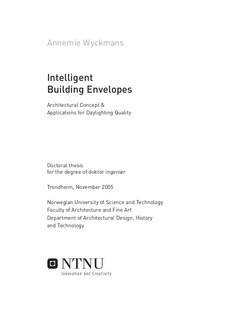| dc.description.abstract | During the past few decades, the term intelligent building envelope has emerged as a building skin designed to meet increasingly varying and complex demands related to user comfort and energy and cost efficiency. The concept is described by a multitude of definitions that range from the use of innovative components and a high-tech visual expression to the rational design, use and maintenance of the building envelope.
Within the scope of this Ph.D., intelligent behaviour for a building envelope has been defined as adaptiveness to the environment by means of perception, reasoning and action, allowing the envelope to solve conflicts and deal with new situations that occur in its interaction with the environment, i.e., the local climate and site, and the individual user needs.
This definition is used to analyse the functions an intelligent building envelope can be expected to perform in the context of daylighting quality, or an optimisation of the indoor luminous environment to the requirements of the individual building occupant. Of particular importance is the co-operation between artificial intelligence and the material, form and composition of envelope elements, allowing the envelope to learn the occupant’s needs and preferences, to choose the most appropriate response in each situation, to make long-term strategies, to anticipate the development of environmental conditions, and to evaluate its own performance.
Simultaneously, it is found that adaptive envelope solutions in no manner reduce the need for envelope design meticulously adjusted to local climate and site and to individual user needs, developed in close co-operation between architects, engineers and manufacturers. All of the sources consulted during the course of this Ph.D. stress time and time again how difficult it is to control the operation of the envelope components according to the local environment, and, simultaneously, how important it is to do so. | nb_NO |
